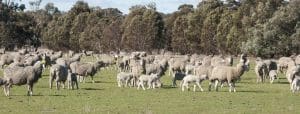
Rainfall has exposed WA sheep to worm and flystrike risks.
WESTERN Australian sheep producers have been urged to drench all their sheep now and monitor flocks for flystrike after heavy falls of unseasonal rain across the state in recent weeks.
The Department of Agriculture and Food said the recent widespread unseasonal rainfall has increased the risks of flystrike and worms to sheep flocks across the agricultural region.
It has urged sheep producers to take action now to protect their livestock and to prevent these risks from becoming exacerbated in coming months.
Rainfall of up to and more than 200 mm have been reported in the state’s Great Southern region in late January-early February, and especially in the Ravensthorpe and south-east areas. Parts of the state were declared natural areas.
Click here to get the latest Sheep Central story links sent to your email inbox.
Drench sheep now, don’t wait
Department veterinary officer Danny Roberts encouraged WA sheep producers to drench all their sheep now, rather than waiting until late March or early April, to protect potential lamb growth rates.
“Using an effective drench is essential, otherwise future problems will be costly, as sheep worm burdens will be higher than expected in coming months.
“It is best to re-check ewes four weeks before the commencement of lambing, by getting a worm egg count done,” Dr Roberts said.
“It is important for producers to make sure chemical products are registered for use, that they follow label directions and observe withholding periods for wool and meat, as well as the export slaughter interval.”
Perfect conditions for flystrike
Department veterinary officer Anna Erickson said flystrike was typically a spring dilemma, but the recent rain, followed by warm weather, had created perfect conditions for flystrike.
“The most susceptible sheep are highly wrinkled Merinos and flocks that have long wool, as well as sheep that have not been crutched or shorn for a long time.
“We also expect to see an increase in incidences of fleece rot and dermatitis, due to sheep being wet for prolonged periods. These fleece conditions will also make sheep more susceptible to flystrike,” she said.
Dr Erickson reminded producers to check their sheep daily and to implement strategic treatments.
“Look for sheep that are on their own and possibly not grazing, as well as dark stains on the wool, especially on the shoulders, back or crutch. Other signs of flystrike include tail twitching, rubbing or chewing at the affected part and an offensive odour.
“Do not rely solely on treating with an insecticide powder or liquid without first clipping away the wool. Clip all the wool from the affected area and then extend the clipped area by five centimetres or so into surrounding unaffected wool,” she said.
The risk of sheep worm burdens has also increased, with more larvae surviving in faeces and increased worm burdens in sheep by autumn, leading to higher worm contamination of new green pasture feed, particularly in as winter approaches.
The department’s free Flystrike Assist app its hard copy Flystrike Chemical Planner document can assist producers with treatments and withholding periods.
For more details visit agric.wa.gov.au and search for ‘flystrike management tools’ or ‘managing flystrike’. More information about worm control is available wormboss.com.au
Source: DAFWA.



HAVE YOUR SAY